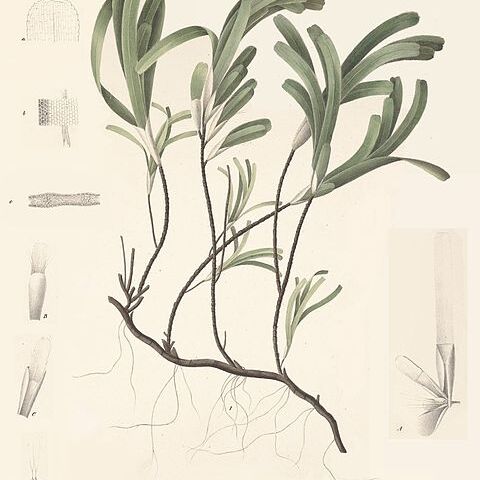Marine, submerged or sometimes intertidal herbs. Rhizome robust, woody, sympodiallybranched, with 1 erect, stiff, unbranched or little-branched stem at every fourth node. Roots 1–5, stiff or wiry, branched or unbranched, arising at nodes preceding stem-bearing nodes. Leaves clustered at ends of branches; leaf sheath compressed, narrowed at base, amplexicaul; sheath shed together with blade, leaving a closed circular scar. Leaf blade linear, flat, almost entire or denticulate; apex rounded, coarsely denticulate; longitudinal veins numerous. Inflorescence terminal on short lateral shoot, enclosed by 4–6 leafy bracts. Male flower subsessile to pedicellate; anthers attached at same level, connate dorsally for whole length, each with a terminal appendage. Female flower: carpels free; style short, with 2 filiform stigmas. Fruit viviparous; young seeding firmly held by basal flaps of succulent innermost floral bract for 4–12 months; released seedling with 3–8 seedling leaves.
Submerse aquatic herbs; rhizome robust, woody, creeping, sympodial, with 1– 2 erect unbranched or little-branched stems at every 4th internode; roots (1– )2(– 5), ± branched, only on the internode preceding the stem-bearing internode. Stem and branches bearing a terminal cluster of leaves. Leaves with sheath compressed, ligulate and auriculate, amplexicaul, shed together with leaf, scar closed; bladelinear, margin spinulose, apex denticulate. Flowers solitary and terminal on short lateral shoots, subsessile, enclosed by 4 leafy bracts. Staminate flower of 2 anthers, dorsally connate over their length, attached at same height, each with terminal appendage; pollen filamentous. Pistillate flower of 2 free ovaries, each with short style and long coiled stigmas. Fruit a combination of the fleshy inner bract and two fertilized ovaries, one usually abortive, often germinating while still attached to the plant; seedling free-floating.

